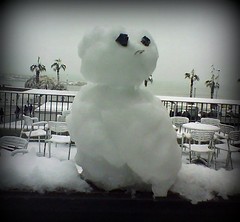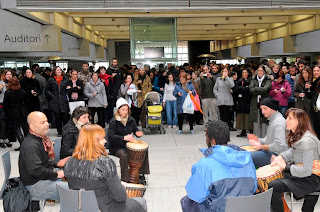
Here's another of the winners (well, a runner-up for the written works) of the El·lipse Award. It was written in English orginally by Joana Domingues Ribeiro.
Born in Lisbon in the 1st of November 1980, Joana has a degree in Microbian Biology and Genetics, and since 2005 she is a student of the GABBA PhD program, at the university of Oporto, Portugal. In 2006 she joined the
CRG, one of the centres at the
PRBB, and currently she is doing her PhD at the laboratory of Luciano Di Croce, in the field of Epigenetics and Chromatin. Last summer she did a short workshop on creative writing and since then she is testing new language tools and developing new ideas to experience the scientific world and herself.
Hope you enjoy it!
THE FIRST INTERVIEWLooking forward to shave some heads, he laid the nervous scissors when suddenly the bell rang. It was the last client of that feminine suffocating night of summer. Faster than a train, a dancer perfume flooded the little hair salon, crossed one of his sighs, and sat in the destiny chair. The request was easy and followed a simple mathematic equation, a short and round fringe and a slight adjustment in the length. What really was impossible was to forget her. Her face was like a soft light that could put him to sleep, the long hair invented a thousand drawings, and the sweet mouth threatened the singing of his favourite song.
Farewell came when his skeletal pale moon hand found her hand, warm and vibrating and he could notice her excitation for the new haircut including some rush to flaunt it. Afterwards not even the luscious liquor could calm him down when his dangerous eyes were chasing, from a remote third floor, the last steps of the mysterious client disappearing happily in the corner of the night. The most beautiful being of the last five hundred years had left his salon and entered his heart. He mechanically washed the small bat face and stilled the weak body that inside was noisy as a Carnival timbrel. Then he closed the daily hairsalon and like a Christmas illumination dazzled the entire subway on the way back home.
At the house entrance Igor, the cat, would wait for him, hungry for tenderness. A subtle hairspray smell dispersed the feline and he took opportunity to conquer his favourite chair half destroyed by the cat’s tedious claws. Several chaotic diplomas in the front wall teletransported him to the past.
His six false identities have allowed him the most diverse jobs in the last five centuries. He started as a pastry cook at the court of king Louis the XIV, and then he travelled to South America and established one-man show at the city of Buenos Aires. In unknown year he accepted a position as a dealer of books and wigs and latter, back to Europe, he attended several university night classes. Nowadays he was a manager of a karaoke bar and a hair salon. However his infinite secret would chase him like the smell of coffin. He was a vampire and since that night he was madly in love with no bite intentions.
Not attractively dark or young looking as count Dracula, he had never hypnotized the victims with gothic chaos. His extremely bad luck dictated that he would be bitten at the age of sixty two.
But how could he, Bruno of Drac, invite that mysterious woman for a duo at his karaoke bar? A grandpa singing “Forever Young” from Alphaville would never interest her. Meanwhile he used the internet and googled “How to become young in one week”. The results redirected him to a myriad of homemade rejuvenation receipts, talismans, hair tonics, medicinal spas, illegal witches, auto-help manuals, and immense authentic virtual maize.
In the last second of despair, mental neons lighted on reading, “American Scientists discovered in induced pluripotent cells the source of eternal youth”. The following words excited him more than a paparazzi shooting a new scandal. Rejuvenation was possible, he scream inside himself like a shrilling megaphone of youth. After two days he flew to the distant California.
Disguised as a journalist, he could enter the building where the American scientists worked, managing an exclusive hour interview with the group leader that had made the amazing discovery.
Surrounded by a hypnotizing white colour he was carried to an unknown dimension. He observed machines working advanced units, and fellows in scientific uniform manipulating invisible ideas. Strangely that underground world of mystery and possibilities mirrored his one. A loud voice coming from the end of an aseptic corridor woke him. A waiting fellow without a lab coat and gloves invited him for a coffee without even questioning why he was wearing sunglasses. This was how he met Dr.W., famous group leader and his first interview experience.
He had prepared the essential questions which together with a small notebook and pocket voice recorder added credibility to his true scientific curiosity. Accepting a hot nervous coffee he stirred the sugar with the first question,
-Dr.W. the international press acclaims you as the father of regenerative medicine but is this in fact revolution?
-Mr. of Drac, you and your fellow journalist have to understand that we are only at the beginning of a process. We could call it revolution if all scientific knowledge would have direct medical applications. Our mission is to unravel the entire potential of stem cells.
-But what exactly are these mysterious stem cells? Where do they come from? And, is it possible to buy them through internet?
-The stem cells are undifferentiated cells that give rise to all kind of cells that you can find in our organs and tissues. All human beings have stem cells so this is something that brings us together. Stem cells can be found in the fertilized egg and in some tissues of the fetal and adult body. Of course they are not for sale and not available for non scientific manipulation.
-But I have heard that your group developed a special kind of reprogrammed cells. Is that right?
-Dear Mr. of Drac we work with a particular kind of stem cells, so called induced pluripotent cells. These are special since they come from a specialized cell, such as a skin cell. What others and we did was to reprogram them to an undifferentiated status similar to that of embryonic stem cells. These latter ones are pluripotents that means that in certain conditions they can give rise to any kind of cell in the body.
-Does that mean that this biological material you expect to sell human youth?
-Mr.of Drac our laboratory is not interested in any kind of commercial profit. For you to have an idea, last week multimillionaire from Plastic Surgery Company proposed us a million dollar business in exchange for knowledge that does not even exist. If Mr. of Drac also wishes any kind of business with us you would better go away right now.
-Dr. W., please relax, I didn’t come to interview you with any commercial interest. I am just curious to know if, in this moment it is possible to convert a man with of age into a young man of age thirty years.
-Very well, I tell you that miracle is impossible right now. You and the general audience have to understand exactly what we are dealing with before drawing such false conclusions. I dislike seeing the work of my team considered a commonplace. What we want is to know if the induced cells can give raise to all kind of specialized cells and what are the conditions for that to occur. Hopefully with this we would be able to repair the function of certain organs or human tissues.
-But meanwhile what are the fruits of your research?
-Mr. of Drac, you cannot really see the art of our research! Our work is interconnected with the one from other researchers that use embryonic or adult stem cells as a model. With all common knowledge, we wish to understand how organisms grow and how the human body keeps on its organs and tissues during life. Only in this way we can understand what occurs in case of disease.
-At the end, Dr. W., don’t you think that there is so much publicity and so little clinical application!
- Please don’t despise all that my team and colleagues achieved. The more we can know about our model the closer we will be to clinical applications. We hope one day to be able to cure pathologies such as cardiac and liver diseases and some advanced cancers. Don’t you think that’s better than aspirin?
Bruno just wanted to bite the middle age man, full of impossible, sit at his front. That was catastrophe. His body trembled and the mouth got dry as a desert. Without even saying goodbye he evaporated from the room and diluted himself in the crowed streets. Finally at home not even Igor the cat could, with its furniture destruction power, wake him from a necrotic sleep walker state. Unexpectedly in a full moon night, a scream of joy disturbed the sleeping kitten. It was not Halloween night but somehow the vampire woke up in a good mood. Some days after the hair salon and karaoke bar were sold and the old vampire changed town and looked for a new life as a scientific researcher. The fake interview opened in him an extreme curiosity for science and stem cell research. He will take part on the biggest discoveries and have all eternity to look for the therapy of the lost youth.



























